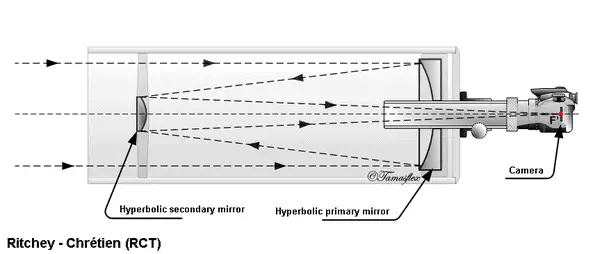Celestron is known for its Schmidt-Cassegrain (SC). But then there’s the Ritchey-Chrétien (RC) type of Cassegrain marketed by the Orion telescope brand. How do these compare? Let’s the important things to know about these SC vs RC telescope types starting with what is a Cassegrain telescope.
What type of telescope is a Cassegrain telescope?
A Cassegrain is a type of reflecting telescope that combines the use of a concave primary and a secondary convex mirror. They are catadioptric. In the classic design, the primary mirror is parabolic with a hole in the center. A Cassegrain has a folded configuration and hence offers a long focal length in a compact design.
What is a Schmidt-Cassegrain telescope?
The Schmidt-Cassegrain (SC or SCT) incorporates the features of both reflector and refractor type telescopes in that it has mirrors and a lens. It is of three types I explored in my my article on the benefits of catadioptric telescopes for astronomy.
The main mirror of an SC is concave just like the Newtonian reflector. At the top of the telescope tube is a lens that functions to correct optical aberrations, prevent dust and pollutant intrusion, and support for a second mirror. The purpose of the second mirror is to reflect and concentrate light back through the hole in the primary mirror. It’s at the rear of the telescope that the light is focused.
Tom Johnson, the founder of Celestron, is credited with designing the SCT in the early 1960s. The early SCTs by Celestron were the C6, C8, C10, C12, C16, and C22.
The main advantage of the SCT over other types of telescopes is its compact design. Compare an 8-inch SCT, which is 2 feet long, with an 8-inch Newtonian, which is over 4 feet, and you’ll know what I mean. Hence why these telescope types are popular planet viewing telescopes for backyard enthusiasts.
What is a Ritchey-Chrétien telescope?
A Ritchey-Chrétien (RC or RCT) is another type of Cassegrain telescope.
This design dates back earlier to the conception of the SCT. It first appeared in the 1910s, an invention of two astronomers, George Willis Ritchey and French astronomer Henri Chrétien, the first an American and the latter French. Hence the name.
Its primary and secondary mirrors are both hyperbolic rather than parabolic mirrors as seen in the Schmidt-Cassegrain.

The advantage of this non-spherical mirror design is that it eliminates coma, an aberration that makes it hard for professional astronomers to estimate astro-distances in the field of view.
With an RC, you get a relatively large field of view. That leaves astigmatism, for which an RC can incorporate a lens to correct and flatten the focal surface.
The RCTs differ from SCTs in that they only use mirrors (no lens). The mirror is supported by four metal vanes.
The RC is suitable for astrophotography and is popular for deep space imaging. In fact they are intended for photography of night sky objects rather than for visual observations. And they have more relevance for the advanced astronomer looking to scientifically study the night sky.
Celestron vs Orion
These are two popular consumer brands of telescopes. I compare these brands in my article on Celestron vs Orion vs Skywatcher, where you’ll find more information.
Sources:
Astronomy Magazine (Oct 2020): Celestron Celebrates 60 Years
Starizona: Ritchey-Chrétiens
